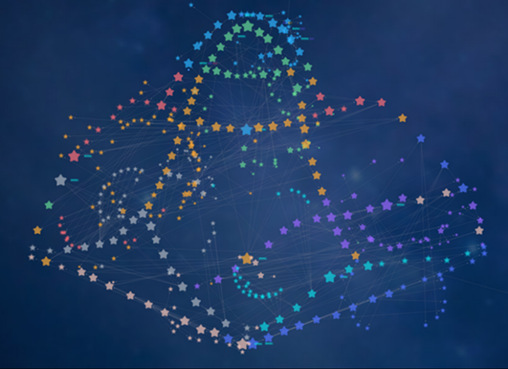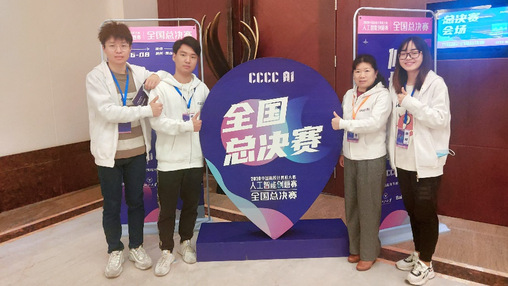Do you really understand “Rednote”, the APP that’s always with you? Do you know that there are rich “gold mines” in the voluminous data? How to “cultivate” interdisciplinary technology pioneers? How do you activate the “straight-A student attributes” hidden in your potential? Perhaps you can find the answers in “new” courses of Donghua University. “AI for All”, artificial intelligence integrates into Donghua University's curriculum development, with “none left out”.

(Innovative Basic AI Courses)
On a sunny winter day, students of DHU hurried to the classroomsearlier than usual early. In the “Computational Thinking and Artificial Intelligence” class, non-computer science majors from colleges such as Textile, Chemical Engineering, and Environment Science and Engineering followed Professor Liu Xiaoqiang from College of Computer Science and Technology as they stepped into the world of AI.
This course is “different”! Donghua University is in the midst of comprehensive reform for its 1+X curriculum system for general AI education. The “1” represents the compulsory course “Computational Thinking and Artificial Intelligence”, which has been fully upgraded and transformed to emphasize the cultivation of computational thinking and enhance students' core abilities to solve practical problemsusing programming. At the same time, it innovatively incorporates cutting-edge AI modules, providing students with a fulfilling practical experiencein developing AI applications through programming.
“Each lesson seems to open a window to the future technology, from simple algorithmic logic to complex neural networks, all packed with useful tips. Additionally, this course is challenging. Some abstract concepts and complex programming practices do require considerable effort to understand, but this challenge also brings a great sense of achievement once overcome.” said Xiao Yu, a 2024 undergraduate student from the College of Materials Science and Engineering, after completing the course.
Integrating general AI education into the compulsory curriculum system of universities has become an inevitable part of higher education reform. Liu Xiaoqiang told reporters that general AI education cannot simply copy specialized courses or aim for technical depth. Instead, it should tailor and integrate teaching content based on the goal of cultivating interdisciplinary talents, balancing intelligent thinking, technology, and application design.
The school has also provided a “buffet menu” of X innovative applied technology elective courses for students who “want more”. This series of courses offer multiple technical directions for students to choose from, catering to the personalized learning needs and interests of students from different disciplines and providing an information technology foundation for “smart+” and “Internet+” innovative applications.

For example, in the national-level first-class course “Data Science Technology and Applications”, students analyze cases such as “corrosion analysis of metallic materials in water”. By collecting relevant data in water resources over the years, students predict future annual total water usage and wastewater discharge volumes, assessing whether wastewater treatment facilities are overloaded...
“Playing with” AI Changes the “Face” of Professional Class
“Hello, I am Weavey, the virtual teaching assistant for the Textile Materials Course Group Virtual Teaching and Research Office. If you need my help, click on my avatar to start a conversation with me...” Weavey, who offers personalized learning plans, intelligent quizzes, interdisciplinary suggestions, and more, has an impressive tech background.

“Textile Materials Science”, a national offline first-class course led by Academician Yu Jianyong, has evolved from traditional teaching, MOOCs, online-offline hybrid to a generative AI+ model, transformingprofessional classes with AI.
Associate Professor Liu Hongling from Donghua University's College of Textiles explained that the construction of smart courses in textile materials uses the Chaoxing Huiya large model as the underlying foundation, creating a course-specific knowledge base as the training data set, combined with retrieval enhancement technology, in order to ensure the availability, reliability, and controllability of AI responses and suggestions.
It is understood that AI tools can assist in the entire process of smart course teaching. For example, before class, teachers can use smart tools such as intelligent writing and AI lesson plans to build course content, while students can actively conduct pre-class previews based on the knowledge graph built by the teacher in advance. During class, teachers can have more time and energy to interact and collaboratively explore with students, and both can use tools such as video understanding to enrich teaching practices. After class, teachers can use AI to analyze students' learning situations, and students can use AI teaching assistants for intelligent Q&A and have more accesses to additional resources.
By embedding artificial intelligence into professional courses, Donghua University has developed a batch of basic or frontier expanded professional courses deeply integrated with AI. In the teaching practice of Donghua University's “History of Chinese Art” course, a “AIGC Virtual Digital Teacher Mini-Class” was particularly set, encouraging students to combine AI means to create virtual digital teachers. Compared with the traditional single presentation method that only includes text and static images, digital teachers offer dynamic displays, meet personalized needs, and have good interactivity, which forms a conducive supplement to universally applicable classroom knowledge and deepens students' understanding of key points in art history.
Associate Professor Feng Mingyang from Donghua University's College of Fashion and Design explained, “In art history theory classes, we encourage students to use AI technology for 'text-to-image/image-to-image' artistic creation on classic works. By adjusting relevant parameters, they can produce similar styles, compositions, or content, helping students better understand the rules of artistic creation and the nature of innovation.”
AI is changing our education and teaching. The above is a glimpse of the “AI for All” teaching reform story on Donghua's campus in 2024. Besides, until today, nearly 100 “Major+ AI” courses have been established. This change stems from the school's vigorous promotion of artificial intelligence to empower first-class undergraduate education and foster the construction of “Major+AI” courses in the past year. The school has achieved positive results in constructing a progressive curriculum matrix consisting of AI computational thinking courses + AI practical innovation application courses + AI professional core courses, upgrading the existing computer curriculum system, launching a continuously AI-empowered curriculum system, and conducting teacher training for digital and intelligent course construction.
“In the context of the AI era, the interactive relationships among several key elements such as teachers, students, knowledge, and abilities have undergone fundamental changes. Every major, every student, and every teacher - ‘none of them can be left behind’. We must proactively embrace the opportunities and challenges, comprehensively enhancing teachers' AI literacy and abilities.” Yang Xudong, Dean of the Academic Affairs Office at Donghua University, told reporters.


